Physical Address
304 North Cardinal St.
Dorchester Center, MA 02124
The esophagus is a muscular tube that transports food and oral secretions from the mouth to the stomach via coordinated peristalsis of striated and smooth muscle. Acquired abnormalities of the esophagus can be separated into several broad categories: gastroesophageal reflux (GER), trauma including foreign bodies, inflammatory conditions, infections, motility disorders, postsurgical changes, neoplasms, and other conditions.
An esophagram or upper gastrointestinal (UGI) series is the most common method used to image the esophagus directly; the esophagram focuses on the esophagus, while the UGI is a more general examination of esophagus, stomach, and duodenum. See Chapter 84 for a description of the technique.
Computed tomography (CT) and magnatic resonance imaging (MRI) are rarely used as primary methods of imaging the esophagus; however, both CT and MRI have the advantage of allowing the radiologist to visualize the esophageal wall and lesions extrinsic to the esophagus. There are several major limitations of cross-sectional imaging in evaluating the esophagus that prevent their use as a primary imaging modality: first, neither CT nor MRI provides functional information of esophageal motility; second, the esophagus is not able to be distended reliably to evaluate wall thickness accurately; third, neither study is able to provide mucosal detail; and finally, CT uses ionizing radiation.
Gastroesophageal reflux is defined as the retrograde passage of gastric contents into the esophagus. When symptoms or lesions occur due to GER, it is referred to as gastroesophageal reflux disease (GERD).
The primary mechanism of GER is transient relaxation of the lower esophageal sphincter. This relaxation can be triggered by a vasovagal reflex initiated by gastric distension or cardiopulmonary receptors, or a swallow that does not trigger esophageal peristalsis. In children, severe GERD has several known underlying risk factors, including neurologic disorders such as spastic quadriplegia and cerebral palsy, esophageal atresia, chronic lung disease such as cystic fibrosis, and hiatal hernia.
GER is ubiquitous in infants, occurring in 100% of 3-month-olds, 40% of 6-month-olds, and 5% to 20% of 1-year-olds. In older children and adolescents, reported prevalence of weekly GERD symptoms increases with age, from 2% of 3- to 9-year-olds to 5% to 8.2% of children aged 10 to 17 years.
The symptoms of GERD depend on age. In infants, symptoms include irritability, feeding difficulty, poor weight gain, and sleep disturbance. In older children, these include heartburn, abdominal pain, regurgitation or vomiting, and dysphagia. Extraesophageal symptoms of GERD include chronic cough, asthma, apnea, bradycardia, sore throat, dental erosions, and recurrent otitis or sinusitis. When compared with adults, children have fewer episodes of heartburn, dysphagia, and chest pain and more episodes of vomiting and regurgitation.
GERD is often diagnosed based on symptoms and a trial of acid-reduction therapy. When symptoms are not specific or are atypical, confirmatory testing can be performed. Intraesophageal pH monitoring has traditionally been considered the gold standard due to its ability to measure the pH in the esophagus over a long period of time. The main limitation of this technique is that patients may have abnormal esophageal acid exposure without symptoms of GERD or retrograde bolus movement in the esophagus. To evaluate for the retrograde passage of gastric contents as well as esophageal acidity, combined pH/impedance probes are used.
According to the North American and European Pediatric Gastroesophageal Reflux Clinical Practice Guidelines, imaging studies are not required to make a diagnosis of GER. UGI is often performed in the setting of GER to evaluate for an anatomic abnormality; however, it should not be used as the primary method of diagnosing GER or GERD. There are multiple limitations of UGI in diagnosing GER, including use of nonstandard techniques, lack of correlation with symptoms, and use of ionizing radiation. Methods used to provoke reflux such as Valsalva maneuver, positional changes, abdominal compression, or leg lifting may increase the sensitivity of detecting GER but lower the specificity. Because there are more sensitive diagnostic tests and the radiologic findings do not correlate with symptoms, the collaborative practice parameter set forth by the American College of Radiology and the Society for Pediatric Radiology do not recommend provocative maneuvers or prolonged fluoroscopy for the detection of GER.
Although UGI should not be prolonged to identify GER, it should be documented when present ( Fig. 98.1 ). The percentage of patients who have GER on UGI decreases with age from 80% of infants less than 18 months to 30% of adolescents between 12 and 18 years old. It should be noted that, although the height of reflux is often reported as a surrogate for its severity, there is no correlation with GERD symptoms.
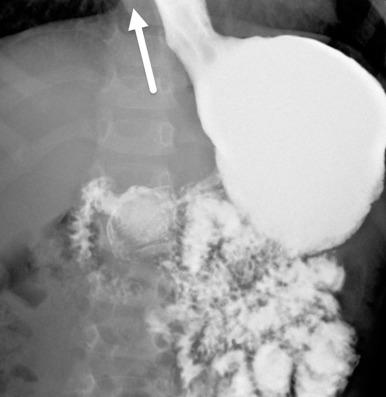
Technetium-99m (Tc-99m) sulphur colloid can also be used to diagnose GER. While scintigraphy is a sensitive method of detecting GER, it suffers many of the same limitations of UGI; mainly, the presence of GER does not correlate with symptoms of GERD and also requires ionizing radiation. A limitation of scintigraphy is its inability to diagnose some of the complications of GERD. Scintigraphy is thus reserved for cases where pH monitoring is not able to be performed or when evaluation of gastric motility is required.
Ultrasound benefits include its low cost, rapid performance, lack of ionizing radiation, and ability to perform a dynamic scan. While the North American and European Pediatric Gastroesophageal Reflux Clinical Practice Guidelines state that ultrasound is not recommended for routine evaluation of GER, some authors have described its use in evaluating the length of the abdominal esophagus, position of the lower esophageal sphincter relative to the diaphragm, and the presence of other potential causes of vomiting such as hiatal hernia.
Esophageal complications of GERD include strictures and Barrett esophagitis. Esophageal strictures, also known as peptic strictures when caused by GERD, typically occur in the lower third of the esophagus and are a result of acidic injury. They are cited as being present in up to 15% of children with GERD and can occur at any age. Many of the patients who develop strictures have an associated comorbidity, with 25% having a neurologic impairment.
Barrett esophagus is defined as metaplasia of cells in the distal esophagus from squamous to columnar epithelium. Its prevalence in children with GERD ranges from 0.25% to 4.8%. Risk factors for developing Barrett esophagus in children include severe chronic GERD, congenital abnormalities, neurologic impairment, hiatal hernia, and family history. While it is associated with a 30-fold increase in esophageal adenocarcinoma in adults, the risk of developing adenocarcinoma is not defined in children.
There are multiple options for treating GERD depending on the patient's age, comorbidities, and severity of symptoms. Generally, lifestyle changes and pharmacotherapy are first-line options. Lifestyle changes include avoidance of overfeeding, thickening feeds, upright positioning during sleep, and avoidance of second-hand smoke. A goal of medical therapy is to decrease the acidity of the refluxed gastric contents. This is generally performed by using proton pump inhibitors and histamine receptor antagonists. In patients with continued severe GERD after pharmacotherapy or who have other comorbidities such as neurologic impairment, antireflux surgery such as Nissen fundoplication is performed. Strictures are treated with esophageal dilation and fundoplication. In a small percentage of patients, severe and recurrent strictures will require extensive and repeated dilatations, and may come to surgical resection or esophageal replacement.
Esophageal injury can occur through ingestion of foreign bodies or caustic substances, blunt injury, or forceful vomiting.
Ingested foreign bodies are common in children with the majority occurring in those younger than 3 years of age. There were 86,261 pediatric foreign body ingestions in 2014 reported to the American Association of Poison Control Centers, representing a fraction of the actual number of foreign bodies ingested.
In the United States and Europe, coins are the most commonly ingested foreign body. It is estimated that there are more than 250,000 coin ingestions per decade. While most coins spontaneously pass through the gastrointestinal tract, they can lodge in the esophagus. Coins typically lodge in one of three locations: the thoracic inlet (60%–70%), midesophagus at the level of the aortic arch (10%–20%), and just above the lower esophageal sphincter (20%). When not witnessed, the patient may present beyond the acute stage.
Symptoms of chronic foreign body impaction include respiratory distress, asthma-like symptoms, cough, nausea, vomiting, and dysphagia. Respiratory symptoms are due to local inflammation surrounding the foreign body. Patients with chronic foreign body impaction are at risk of esophageal perforation.
Radiographs are useful to identify the location of the coin and to look for signs of chronic impaction ( e-Fig. 98.2 ). Coins are generally described as oriented in the coronal plane when located in the esophagus on the frontal radiograph, although there have been reports of sagitally oriented esophageal coins. Inflammatory changes that develop in patients with chronic foreign body impaction cause thickening of the space between the esophagus and trachea on lateral chest radiographs, and often tracheal narrowing ( e-Fig. 98.2B ); lateral radiographs are therefore useful in patients in whom the episode was not witnessed and the time course is not known. Esophagram may be performed in patients with a chronic foreign body impaction after removal to evaluate for perforation or development of a tracheoesophageal fistula.
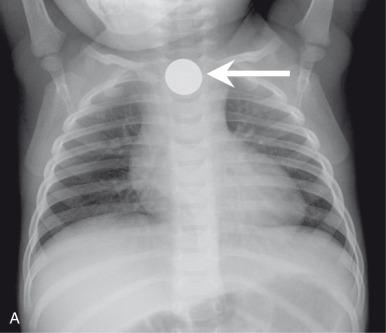
Coins, like other esophageal foreign bodies, can be removed via Foley catheter balloon extraction or endoscopy. Foley catheter extraction has been used as a safe and effective method of coin removal in children older than 1.5 years with acute ingestion, before the development of esophageal edema. Despite its history of safe extractions and lower cost, Foley balloon extraction has fallen from favor due to concerns for patient safety related to airway compromise or esophageal injury. Endoscopy is now the preferred method for extraction at most centers.
Esophageal injury in children caused by button battery ingestion is increasing in frequency. This increase in injury is thought to be due to an increase in size of the batteries coupled with the shift to a lithium cell. Button batteries are often found in objects such as watches, calculators, toys, and hearing aids. Management of battery ingestion is different than that of coins because batteries lodged in the esophagus can cause severe damage in as little as 15 minutes. Tissue damage is caused primarily by the generation of hydroxy ion radicals in the mucosa. This results in a caustic injury from high pH.
If ingestion is witnessed, extraction should occur before the development of symptoms. If these develop, they include drooling, chest discomfort, choking, gagging, and airway obstruction. Damage can include esophageal perforation, or fistula to the trachea or to the aorta leading to exsanguination. Children at greatest risk for developing aortoesophageal fistula are those younger than 5 years of age and those who have ingested batteries larger than 20 mm.
Imaging is crucial in the diagnosis and management of button battery ingestion. Batteries can be distinguished on radiographs by their characteristic halo appearance with a circle of lucency just within the outer border ( Fig. 98.3A and B ).
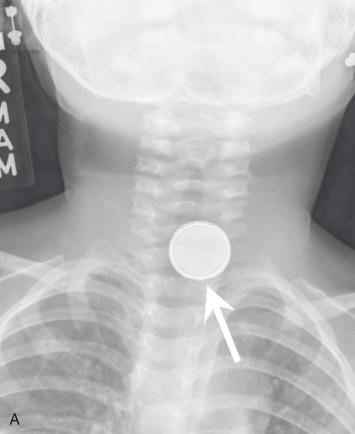
Progression of injury, even days to weeks after the battery ingestion, is a hallmark of this disease entity. Therefore imaging plays a role in the continued management of these patients. Esophagram with water-soluble iso-osmolal contrast can be performed after removal to evaluate for the presence of complications, such as esophageal perforation or tracheoesophageal fistula. ( Fig. 98.3C and eD ). Long-term complications, such as esophageal stricture, can also be diagnosed.

Recently, the North American Society for Pediatric Gastroenterology, Hepatology, and Nutrition (NASPGHAN) has advocated for CT or MR angiography in the setting of a button battery ingestion when an esophageal injury is identified at the level of the aorta on endoscopy. This recommendation was echoed by the Button Battery Task Force which further recommended using CT or MRI to evaluate for signs of mediastinitis and inflammation surrounding the aorta.
If a battery is lodged in the esophagus, the requesting clinician should be contacted immediately to arrange emergent extraction. Follow-up imaging may be indicated, as previously discussed. There is no consensus recommendation for follow-up in the setting of esophageal inflammation, mediastinitis, or inflammation surrounding the aorta.
Impacted food boluses are relatively infrequent in children but may represent the initial presenting symptom of eosinophilic esophagitis, peptic stricture, achalasia, vascular rings, or an extrinsic mass. Eosinophilic esophagitis is the major cause of food bolus impaction in children accounting for more than 50% of all cases. The second most common cause is an area of narrowing in a patient with prior esophageal atresia repair or Nissen fundoplication surgery.
Acute impaction of food typically leads to symptoms of dysphagia and drooling; difficulty swallowing may lead to aspiration.
On esophagram, an impacted food bolus appears as a persistent filling defect in the esophagus ( e-Fig. 98.4 ). The impacted food can completely obstruct the esophagus. This is seen on esophagram as a standing column of contrast that does not pass beyond the food bolus.
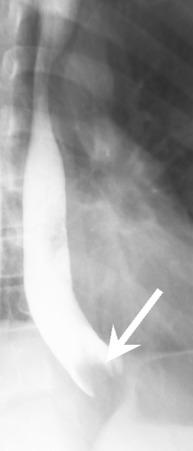
When identified, the food bolus is removed endoscopically. Esophagram can be performed after extraction or passage of the food bolus, to evaluate for the underlying cause, if not already known. Esophageal biopsy is recommended in patients diagnosed with food bolus impaction to assess for eosinophilic esophagitis, particularly in those who do not have a history of prior esophageal surgery.
Ingestion of caustic materials in childhood is relatively common and typically accidental. In 2014, there were 198,018 ingestions of household cleansers reported to the American Poison Control Centers, more than 65% of which occurred in children. The age group at highest risk for caustic ingestion is children under 5 years of age, with a peak around 2 years when children are learning to explore but not yet able to distinguish between harmless and harmful substances.
The extent and severity of injury depends on several factors: the corrosiveness of the ingested substance, the quantity ingested, the physical state of the substance, the duration of the contact time of the substance with the esophagus, and subsequent secondary infection.
A variety of substances can cause a caustic injury, including alkalis (pH up to 12), acids (pH as low as 2), and bleaches (pH near 7). In contrast to acidic substances that are sour, alkalis have a relatively innocuous taste, leading to a greater volume ingested. Further, alkaline agents produce liquefaction necrosis and rapid penetration leading to more severe injury.
After caustic ingestion, patients with severe injury typically present with pain, drooling, and airway symptoms; more visible signs of tissue damage include lip swelling, mouth ulcers, and erythema of the tongue. Esophageal stricture is an important late complication with a reported frequency between 2% and 63% of patients. A stricture can form in as little as 3 weeks after injury.
Initial management of patients with caustic ingestion includes a radiograph of the chest and lateral neck to evaluate for pneumomediastinum. Esophagram is not indicated in the acute phase because it delays endoscopy and does not detail mucosal injuries.
When strictures develop, they can be diagnosed based on symptoms, and confirmed with esophagram ( Fig. 98.5 ). Caustic strictures can be focal or occupy a long segment of the esophagus depending on the substance ingested; acid ingestion typically causes a focal or short segment stricture while alkali substances cause a long segment stricture. Strictures most commonly occur in the upper or midesophagus. Multiple strictures can also occur.
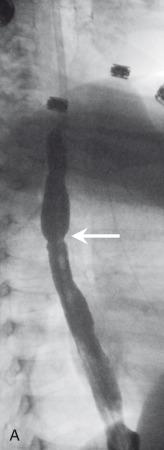
Acutely patients are treated with steroids, proton pump inhibitors, and antibiotics; endoscopic evaluation is performed to assess the extent of damage and to grade the injury. Strictures are first treated with balloon dilation under fluoroscopy. The advantage of balloon dilation over dilation using a bougie is that balloons dilate strictures in a radial direction rather than a longitudinal direction. This is thought to be less likely to cause an esophageal perforation. After the balloon is inflated and the waist is seen to disappear, an esophagram is performed to evaluate for a leak that occurs in 4% to 30% of patients. If balloon dilation fails, operative treatment with stricture resection is performed; esophageal replacement may be necessary.
Patients with a history of caustic ingestion are at risk of developing squamous cell carcinoma of the esophagus. These patients should undergo endoscopic surveillance as adults.
Pill esophagitis is an injury caused by medications; the drugs most frequently implicated are doxycycline and alendronate. Other drugs reported to cause esophageal injury include nonsteroidal antiinflammatory drugs, potassium chloride, ferrous sulfate, phenytoin, and quinidine. Characteristics of medications that are more likely to cause esophageal injury include the acidity of the medication and a capsule formulation that renders it more likely to stick in the esophagus. Pill esophagitis is also more likely to occur in patients with delayed esophageal transit time including taking a pill with little or no water immediately before going to bed, decreased saliva production, and anatomic areas of narrowing.
Patients with pill esophagitis typically present with dysphagia, odynophagia, and chest pain. Pill esophagitis can often be diagnosed by history alone.
Esophagram is not commonly performed due to the classic history but can show a circular area of ulceration. If endoscopy is performed, a circular ulceration is identified with normal surrounding mucosa. The ulceration typically occurs at an anatomic area of narrowing such as at the level of the aortic arch, left mainstem bronchus, or gastroesophageal junction.
Pill esophagitis is treated and prevented with changing pill-taking habits (taking pills with more water, taking pills long before going to bed), crushing pills, taking a liquid suspension, or switching medications.
Iatrogenic trauma is the most common cause of esophageal perforation in children, representing 75% to 85% of all cases. Esophageal perforation can be life-threatening as the esophagus lacks a serosa, and the surrounding loose areolar connective tissue is unable to prevent the spread of infection; thus oral flora and digestive enzymes are able to spread to the mediastinum.
The most common cause of iatrogenic perforation in children is from stricture dilation (see Fig. 98.5B ). Other causes include complications of nasogastric tube placement, endotracheal intubation, endoscopy, pedicle screw placement, and sclerotherapy of esophageal varices. The typical location of perforation depends on the age of the patient. In neonates, perforation typically occurs in the cervical esophagus at the pharyngeal/esophageal junction. (See Chapter 96 .)
Neonates often present after a difficult intubation with nonspecific symptoms, including drooling, choking, or coughing with feeds. In older children, perforation is more common in the thoracic esophagus. They typically present with respiratory distress, chest pain, or subcutaneous emphysema.
The initial diagnostic examination is often frontal and lateral radiographs of the chest. Findings on the chest x-ray include pneumothorax, pneumomediastinum, pleural effusion, and, if the event was caused by nasogastric tube placement, an abnormal course of the tube may be seen ( Fig. 98.6 ). The location of the perforation can often be determined from the radiograph. Left-sided pneumothorax and effusion are more likely to occur in the setting of an upper thoracic perforation while right-sided findings are more likely to occur with perforations in the distal esophagus.
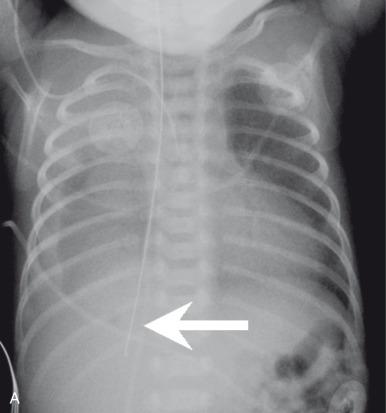
Esophagram can be useful in diagnosing and locating a perforation. Water-soluble iso-osmolal contrast should be used first. If no contrast extravasation is noted, barium may then be used, as it is more sensitive in the detection of an esophageal leak. Three patterns of perforation have been described on esophagram: a local cervical leak is identified if there is a retropharyngeal pocket of contrast; a submucosal leak appears as a linear tract posterior and lateral to the esophagus; finally, free perforation appears as contrast flowing into the pleural space.
CT is not generally used to diagnose an esophageal perforation; however, in a complex, acutely ill patient, this may be the first study performed. Signs of esophageal perforation on CT include pneumomediastinum, mediastinal fluid, esophageal wall thickening, and a catheter extending beyond the esophagus.
Treatment usually consists of expectant medical management, with broad spectrum antibiotics, pleural drainage via chest tube and nutritional support with total parenteral nutrition or gastrostomy; a nasogastric (NG) tube may be placed beyond the perforation under direct visualization. Operative exploration is considered in patients in whom the above more conservative management fails.
The esophagus is rarely injured after chest trauma due to its flexibility and ability to decompress via the mouth and stomach. Reported causes of esophageal injury include handlebar injury, crush injury, opening a bottle of carbonated drinks in the mouth, and child abuse. Tracheoesophageal fistula is an even rarer complication of trauma.
Become a Clinical Tree membership for Full access and enjoy Unlimited articles
If you are a member. Log in here